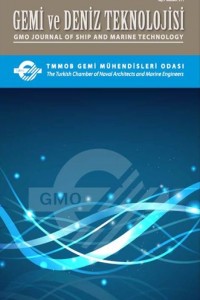Öz
Gemiler üzerindeki biyolojik yüzey kirliliği direnç artışı, yakıt tüketimi artışı, GHG emisyonlarının artışı ve zararlı canlı türlerinin taşınımı gibi hem ekonomik hem de çevresel açılardan önemi artmakta olan bir problemdir. Gemi boyaları, gemi yüzeyindeki biyolojik kirlenmeyi azaltmak ve gemi yüzeyini pürüzsüzleştirmek için yaygın olarak kullanılmaktadır. Bu çalışma, gemilerde kullanılan antifouling boyalar ile ilgili yeni bakış açıları ve yaklaşımları tanıtmayı amaçlamaktadır. Çalışmada ilk olarak gemiler üzerinde oluşan yüzey kirliliği ve bu kirlenmeyi önleme yöntemleri kısaca anlatılmaktadır. Devamında boya / yüzey kirliligi hidrodinamiği ile ilgili son araştırmalar sunulmaktadır. Sonrasında ise antifouling boya teknolojisinde biyo-benzetim (biomimetic) yaklaşımı, bio-ilham (bio-inspired) antifouling boya stratejileri ve bio-ilham antifouling boyaların dizaynında karşılaşılan zorluklar detaylı olarak tartışılmaktadır. Gemi boyaları konusunda sürdürülen araştırmaların, insan yapımı deniz yapıları ve deniz yaşamı arasındaki uyumu korurken, gemi yüzey kirliliğinin etkili bir şekilde azaltılmasına olanak sağlayacağına inanılmaktadır.
Anahtar Kelimeler
Gemi boyaları boya/yüzey kirliliği hidrodinamiği biyo-benzetim.
Kaynakça
- ABS. (2011). Surveyor [Online]. Available: http://www.eagle.org/eagleExternalPortalWEB/ShowProperty/BEA%20Repository/News%20&%20Ev ents/Publications/Quarterly/Surveyor/2011/Surveyor_2011Fall 14/07/2013]. Alzieu, C. L., Sanjuan, J., Deltreil, J. P. and Borel, M. (1986). Tin contamination in Arcachon Bay: Effects on oyster shell anomalies. Marine Pollution Bulletin, 17, 494-498. AMBIO. (2005). AMBIO: Advanced nanostructured surfaces for the control of biofouling [Online]. http://www.birmingham.ac.uk/generic/ambio/index.aspx. Atlar, M. (2008) An update on marine antifoulings. 25th ITTC Group Discussions 3 – Global Warming and Impact on ITTC Activities, Fukuoka, 2008. Baum, C., Meyer, W., Stelzer, R., Fleischer, L. G. and Siebers, D. (2002). Average nanorough skin surface of the pilot whale (Glibicephala melas, Delphinidae): considerations on the self-cleaning abilities based on nanoroughness, Mar. Biol. 140, 653–657. Bechert, D.W., Bruse, M. and Hage, W. (2000). Experiments with three-dimensional riblets as an idealizedmodel of shark skin’, Exp. Fluids 28:403–12. Bers, A. and Wahl, M. (2004). The influence of natural surface microtopographies on fouling’, Biofouling 20 43–51. Bixler, G.D. and Bhushan, B. (2012). Biofouling: lessons from nature. Phil. Trans. R. Soc. A 2012 370, 2381-2417. BYEFOULING. (2013). BYEFOULING: Low-toxic cost-efficient environment-friendly antifouling materials [Online]. http://cordis.europa.eu/project/rcn/110983_en.html. Candries, M., Atlar, M. and Anderson, C. (2003). Estimating the impact of new-generation antifoulings on ship performance: the presence of slime. Journal of Marine Engineering & Technology, 2, 13-22. Chambers L.D., Stokes K.R., Walsh F.C. and Wood R.J.K. (2006). Modern approaches to marine antifouling coatings. Surface & Coatings Technology 201: 3642–3652. Champ, M. A. (2003). Economic and environmental impacts on ports and harbors from the convention to ban harmful marine anti-fouling systems. Marine Pollution Bulletin, 46, 935-940. Dafforn, K. A., Lewis, J. A. and Johnston, E. L. (2011). Antifouling strategies: History and regulation, ecological impacts and mitigation. Marine Pollution Bulletin, 62, 453-465. de Nys, R. and Steinberg, P.D. (2002). Linking marine biology and biotechnology. Current Opinion in Biotechnology 13 (3), 244-248. Demirel YK, Khorasanchi M, Turan O, Incecik A and Schultz MP. (2014). A CFD model for the frictional resistance prediction of antifouling coatings. Ocean Engineering.89:21-31. Demirel, Y.K., Turan, O., Incecik, A. (2017a). Predicting the effect of biofouling on ship resistance using CFD. Applied Ocean Research 62, 100-118. http://dx.doi.org/10.1016/j.apor.2016.12.003 Demirel, Y.K., Turan, O., Incecik, A., Day, S., Fang, H.I., Downie, S., Olsen, S.M. (2015). Experimental determination of the roughness functions of marine coatings. In: Proceedings of International Conference on Shipping in Changing Climates (SCC 2015), 24 – 26 November 2015. Glasgow, UK. Demirel, Y.K., Uzun, D., Zhang, Y., Fang, H.-C., Day, A.H., Turan, O. (2017b). Effect of barnacle fouling on ship resistance and powering. Biofouling 33 (10), 819-834. https://doi.org/10.1080/08927014.2017.1373279 FOUL-X-SPEL. (2011). FOUL-X-SPEL : Environmentally friendly antifouling technology to optimise the energy efficiency of ships [Online]. http://www.foulxspel-antifouling.com/. Gibbs, P. and Bryan, G. (1986). Reproductive failure in populations of the dog-whelk, Nucella lapillus, caused by imposex induced by tributyltin from antifouling paints. Journal of the Marine Biological Association of the United Kingdom, 66, 767-777. IMO (2009). International Shipping and World Trade Facts and Figures, Maritime Knowledge Centre. London. IMO. (2001). International convention on control of harmful anti-fouling systems on ships. Kempf, G. (1937). On the effect of roughness on the resistance of ships. Trans INA, 79, 109-119. Kesel, A. and Liedert, R. (2007). Learning from nature: non-toxic biofouling control by shark skin effect. Comp. Biochem. Physiol. A. 146, S130. Lang A.W., Motta P., Hidalgo P. and Westcott M. (2008). Bristled shark skin: a microgeometry for boundary layer control?’, Bioinsp. Biomim. 3:046005. LEAF. (2012). LEAF: Low emission antifouling coatings based on the novel discovered post settlement penetration triggered antifouling [Online]. http://leaf-antifouling.eu/. Milne, A. (1990). Roughness and drag from the marine paint chemist’s viewpoint. Marine Roughness and Drag Workshop, 1990 London. Okay, O. S. (2004). Antifouling içeren gemi boyalarının uluslararası kurallar çerçevesinde kirletici etkilerinin incelenmesi. TMMOB, Gemi Mühendisliği Odası, Gemi Mühendisliği ve Sanayimiz Sempozyumu, 24-25 December 2004 Istanbul, Turkey. Owen, D., Demirel, Y.K., Oguz, E., Tezdogan, T., Incecik, A. (2018). Investigating the effect of biofouling on propeller characteristics using CFD. Ocean Engineering. https://doi.org/10.1016/j.oceaneng.2018.01.087 Ralston, E. and Swain, G. (2009). Bioinspiration—the solution for biofouling control?. Bioinspir. Biomim. 4, 015007. Salta, M., Wharton, J.A., Stoodley, P., Dennington, S.P., Goodes, L.R., Werwinski, S., Mart, U., Wood, R.J.K., and Stokes, K.R. (2012). Designing biomimetic antifouling surfaces', Phil. Trans. R. Soc. A 2010 368, 4729-4754. Schultz, M. P. (2007). Effects of coating roughness and biofouling on ship resistance and powering. Biofouling, 23, 331-341. SEAFRONT. (2014). SEAFRONT: Synergistic fouling control technologies [Online]. http://cordis.europa.eu/project/rcn/111293_en.html. Taylan, M. (2010). An overview: effect of roughness and coatings on ship resistance. International Conference on Ship Drag Reduction SMOOTH-SHIPS, 2010 Istanbul, Turkey. Van Rompay, B. (2012). Surface Treated Composites White Book, Tahoka Press. Wahl, M. (1989). Marine epibiosis. I. Fouling and antifouling: some basic aspects. Marine Ecology Progress Series, 58, 175-189.
Ayrıntılar
| Birincil Dil | Türkçe |
|---|---|
| Konular | Mühendislik |
| Bölüm | Makaleler |
| Yazarlar | |
| Yayımlanma Tarihi | 31 Ekim 2018 |
| Yayımlandığı Sayı | Yıl 2018 Sayı: 213 |


